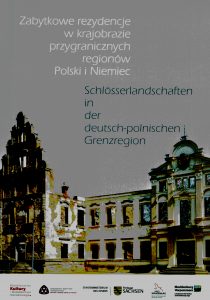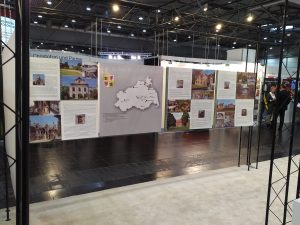Exhibition Awarded Gold Medal: Manors in the German-Polish Border Region
Paul Zalewski
Professor at the European University Viadrina in Frankfurt/Oder (Germany)
 As already announced (newsletter 22.06.2016), an informal expert group named “Manorial Landscapes in the German-Polish Border Region” was established two years ago. The group consists of directors of the heritage authorities and the ministries in charge in both countries. The involved institutions represent the three German federal states, Sachsen, Brandenburg, and Mecklenburg-Vorpommern, as well as the three Polish districts, Dolnoslaskie, Lubuskie, Zachodniopomorskie, all situated along the common borderline. The group is focused on the exchange of practical experiences pertaining to the safeguarding and remediation of manors in the area in question. How big the challenge is becomes understandable when we look back at the postwar period.
As already announced (newsletter 22.06.2016), an informal expert group named “Manorial Landscapes in the German-Polish Border Region” was established two years ago. The group consists of directors of the heritage authorities and the ministries in charge in both countries. The involved institutions represent the three German federal states, Sachsen, Brandenburg, and Mecklenburg-Vorpommern, as well as the three Polish districts, Dolnoslaskie, Lubuskie, Zachodniopomorskie, all situated along the common borderline. The group is focused on the exchange of practical experiences pertaining to the safeguarding and remediation of manors in the area in question. How big the challenge is becomes understandable when we look back at the postwar period.
Because of the approximately 200 kilometer westward shift of the Polish border in the aftermath of the Potsdam Treaty of 1945, the new borderline divided the extended manorial landscape with its numerous big estates. Despite different national settings, the manors in the GDR and Poland came into similarly poor political and economic situations in the framework of socialism. They were affected by compulsory expropriations and a change to a collectivist agriculture. Additionally, many of them were now situated in the depopulated, strongly militarized border zone. Although several manors were adapted to other social functions, such as offices of state-owned agricultural farms, schools, and kindergartens, the lack of proper care led to a creeping decline. Characteristic of both countries is the treatment of manors and estates after political changes of 1989. Due to privatization, both the landed estates and the manors belonging to the governmental agencies were separately sold to private investors. This way of privatizing property proved to be controversial. Since then, a purchase of an isolated manor without its natural surroundings has become unattractive. This is only one of the explanations as to why there are so many manors and estates in an unsatisfying condition on both sides of the border.
 As its first action, the expert group decided to prepare a bilingual exhibition of manors located in the region in question in order to raise the awareness of the general public to the problem of safeguarding the use of manors. Every district delivered information about nine manors, displaying three cases of successful remediation, three of work-in-progress projects, and three of acutely endangered objects. The quite extensive exhibition was shown for the first time during the biannual Heritage Conservation Fair in Leipzig in November 2016, the biggest fair of this type ever held in Europe. The jury of the fair awarded the exhibition with a Gold Medal. This award showed the jury’s appreciation for the form of cultural diplomacy provided by the conservators. Since then the exhibition has been shown in the headquarters of the Silesian Administration in Wroclaw (Breslau). The next presentations are already set: in January in the Saxonian State Chancellery in Dresden, and in February in the Agency of the State Brandenburg in Brussels.
As its first action, the expert group decided to prepare a bilingual exhibition of manors located in the region in question in order to raise the awareness of the general public to the problem of safeguarding the use of manors. Every district delivered information about nine manors, displaying three cases of successful remediation, three of work-in-progress projects, and three of acutely endangered objects. The quite extensive exhibition was shown for the first time during the biannual Heritage Conservation Fair in Leipzig in November 2016, the biggest fair of this type ever held in Europe. The jury of the fair awarded the exhibition with a Gold Medal. This award showed the jury’s appreciation for the form of cultural diplomacy provided by the conservators. Since then the exhibition has been shown in the headquarters of the Silesian Administration in Wroclaw (Breslau). The next presentations are already set: in January in the Saxonian State Chancellery in Dresden, and in February in the Agency of the State Brandenburg in Brussels.
Let’s hope that presentations of the exhibition in politically highly prominent places will give higher priority to the inclusion and protection of our manorial heritage in rural development planning, and provide quick help for the restoration of endangered buildings at the national, regional, and EU level. At the very least, the manors and parks have now been given more importance, and are not only considered an asset of historic and aesthetic value, providing the opportunity to foster the local economy by tourism. Manors are important examples of transnational cultural and economic networks. As such they present an important historical and visually attractive narrative, enriching the European cohesion policy today. This goes well with the idea behind ECHY 2018. In view of the current crisis of European values and ideas, we have to constantly remember the importance of our heritage.